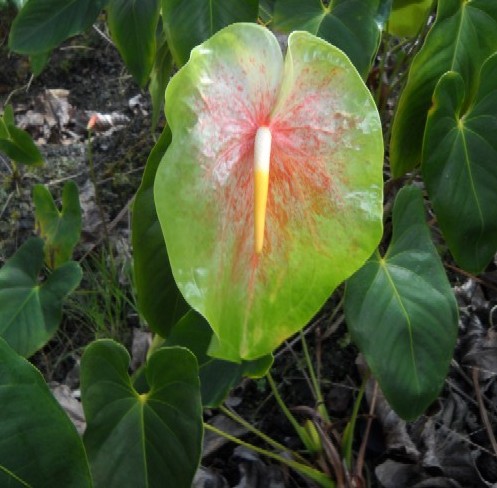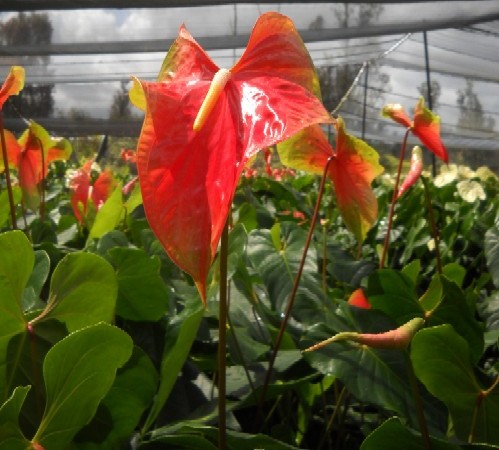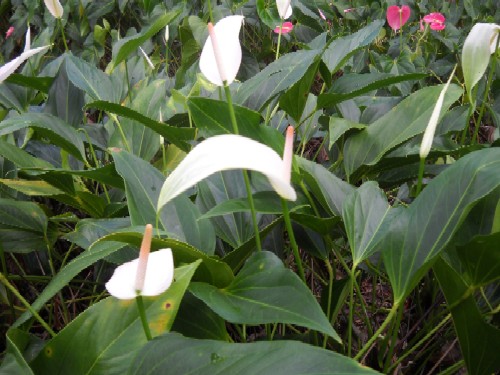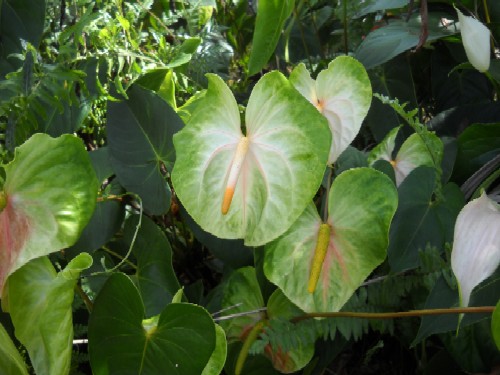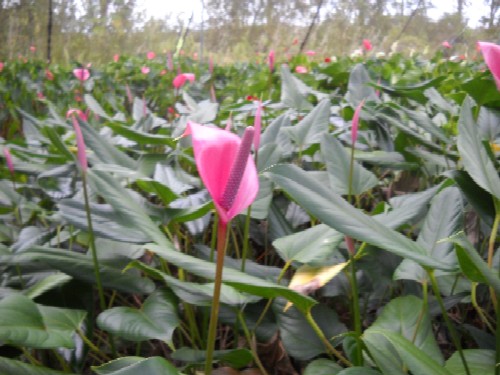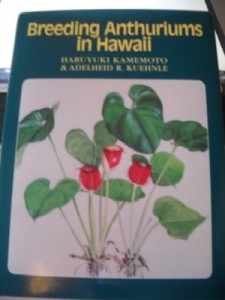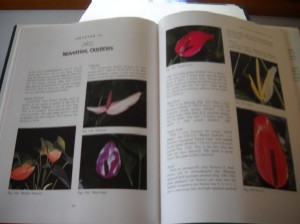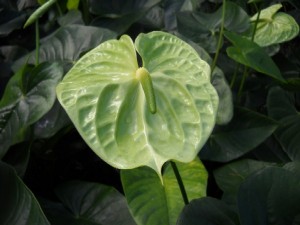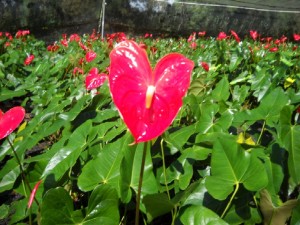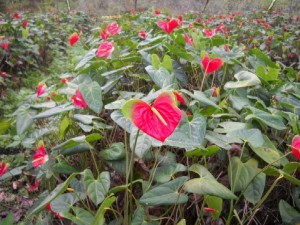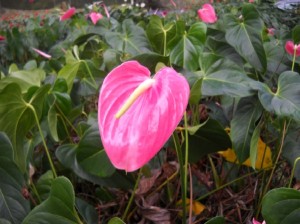Private Reserve
Here are pictures of the rarer and more exotic varieties of anthurium plants that we grow on our farm. They are not for sale at the moment, but from time to time we may offer them for sale. When we do sell them, they will only be available in extremely limited quantities.
If you would like to receive notice when we sell these scarce varieties, please make sure that you are on our mailing list.
Anthurium Brown Leaves
Ever wonder why your anthurium’s leaves are turning brown? Here are four possible reasons.
Old Age
At some point all leaves get old and they die. When this happens they start to turn yellow and then they start to turn brown. This is perfectly natural and perfectly normal. You can leave old leaves on the plant and let them fall off naturally. But in general I like to trim them off, since this makes our plants look better. Just remember to sterilize your cutting shears before doing this with a little rubbing alcohol. Or you can break of the leaves with your hands, grasp the base of the petiole and apply a downward pressure and the leaf should snap off.
Too Much Sun
If you have placed your plant in a spot where it can receive direct sunlight, it might be getting sun burnt. If all the leaves start to turn yellow at the same time and then start to turn brown, this may be a sign of sunburn. Try moving your anthurium to a slightly less sunny location or try to filter out a portion of the sunlight with a thin, filmy curtain. Or you can have the window next to your anthurium plant tinted. If you use a curtain, remember that it shouldn’t block out all of the sunlight. It should only block a portion of it.
Lack of Nutrition
If your plant has started growing slower than normal or if its new leaves are smaller than its old leaves, it may be suffering from a nutrient deficiency. Deficiencies in the major macro nutrients like Nitrogen, Phosphorous or Potassium can all cause leaves to turn brown, so can deficiencies in Calcium or Magnesium.
If nutrition is the issue, you can resolve it by using a liquid fertilizer for a few weeks. And after your plant has recovered you can switch to a controlled release fertilizer. When using liquid fertilizer dilute it to about 25% of the strength recommended on the label and use it once per week. Once your plant recovers, you can use it every two weeks or switch to controlled release fertilizer.
Fungal Problems
Fungal problems (like root rot) can also cause leaves to turn brown. In addition you can be feeding your plant well and it won’t be able to absorb the nutrition if its root system is compromised. If the roots of your plant are turning brown or black and feel mushy or slimy this is a sign of root rot. Healthy roots should be whitish or pinkish. If your plants roots don’t look so good, your best bet is to repot your plant. Make sure you use a good potting soil that drains well. To make a potting soil drain well you should incorporate redwood bark or perlite. When repotting your plant trim off the diseased portions of its main stem and roots using sterilized shears. After repotting be very careful with watering, never let your plant’s soil dry out completely, but conversely you must make sure that it never becomes soaking wet. Excess water allows nasty fungi to grow and causes root rot.
Breeding Anthuriums in Hawaii
If you are looking for a step by step guide to breeding anthuriums, this book isn’t for you. It does give a brief summary of the steps involved in pollinating anthuriums and germinating the resulting seeds, but I feel that it assumes that the reader already understands how to do this and also knows how to raise and care for anthuriums. It also discusses micro-propagation, e.g. tissue culture, and genetic engineering, but this is probably beyond the scope of most enthusiasts.
But if you are looking for background on: Hawaii’s anthurium industry, the major anthurium species, the origins of many of today’s best cultivars, and the inheritance of color traits, this is the book for you. And if you like pictures of anthuriums, this book has a lot of full color pictures of many different varieties of anthuriums.
Click Here To Buy This Book On Amazon.
This book starts out by providing an overview on the major groupings of anthurium species. Then it covers the relationships between species. It gives a partial indication of which species can be interbred and which species the authors were unable to cross. It has a large table with the chromosome counts of various species, which can be helpful when selecting species to crossbreed.
It also describes some of the interspecific hybrids that the authors were able to successfully create and it also provides pictures and descriptions of these hybrids. This is a good starting point if you are thinking of producing your own hybrids.
There’s a chapter on the inheritance of color. If you cross a red and a white, you would think that you’d get pink, but this is not always the case. Sometimes you get orange. Who would expect that? This chapter goes on to cover many of the crosses between the five major color groups.
This book also covers breeding of standards, obake and potted as opposed to cut flower cultivars. It even has a section on novelties and oddities. Did you know that there’s a very unusual novelty named “satan”? It is one of the most unusual looking anthuriums that I’ve ever seen.
This book was written by Professor Haruyuki Kamemoto and Adelheid Kuehnle. Professor Kamemoto is emeritus professor of horticulture at the University of Hawaii and he is one of the founding fathers of the anthurium industry in Hawaii. He started the U.H.’s anthurium program in 1950 and has been developing new varieties of anthuriums for more than fifty years. He has also done amazing things for Hawaii’s orchid industry, too. Talk about a talented guy.
Click Here To Buy This Book On Amazon.
If you buy it directly from Amazon, this book costs over $30. But if you are lucky like I was, you may be able to find a new copy selling for less than $10 from one of the other vendors in the Amazon store.
Green Anthurium
Have green anthurium flowers or plants delivered right to your doorstep. We grow these green midori anthuriums on the slopes of the Kilauea Volcano. We sell flowers for $3.50 per stem and plants for $29 per top cutting. Click Here to Order Now.
Flowers
Midoris are one of the more durable anthurium flowers. They are slightly sturdier and a little more difficult to crease or bruise, so they hold up to shipping very nicely. They are also one of the longer lasting varieties and have a vase life of several weeks. When these flowers are left on the plant, rather than cut, they tend to develop reddish, copper colored highlights that can make them look even more attractive. The word “midori” is Japanese for the word “green,” so this is an apt moniker for them.
Plants
Green Midori anthuriums were developed by an anthurium breeder known as Calvin Hayashi in 1985. He did a very good job on this variety as they grow very energetically and their internodes are on the shorter side, so they aren’t as unwieldy as other varieties. We grow quite a number of these plants on our farm as their flowers are in very high demand.
How To Pack Anthurium Plants For Shipping
In this video, Samantha demonstrates how we pack our anthurium plants for shipping. This method tends to work well for shipping plants, though we do run into the occasional broken flower. Flowers are much harder to ship when they are still attached to plants as opposed to when they are packed as cut flowers.
Video Summary
- Wrap the roots of the anthurium with damp paper towels, so that they don’t dry out.
- Wrap clear plastic wrap around the paper towels, so that they retain the moisture and prevent the water from leaking into the box.
- Carefully wrap the anthurium plant and its leaves with newspaper to protect them.
- Use tape to secure the newspaper.
- Don’t forget to label the plant with a permanent marker.
- Use packing peanuts or shredded newspaper as padding when placing the anthuriums into their box for shipping.
Red Anthurium Flowers and Plants
Our red anthurium flowers are the perfect gift when you want to express a burning passion for that special someone in your life. Red is the color of passion and love, and it is also the color of bravery, strength and courage under fire. We sell large red anthuriums for only $3.25 per stem. We will soon be offering top cuttings of red Princess Lily Anthuriums for $29 per plant.
Click Here To See Our Catalog.
Red Anthurium Flowers
A number of years ago, before plant breeders started working with them, anthuriums were much plainer than they are now. They produced smaller, less colorful flowers. Thanks to the effort of plant breeders, today, we have a plethora of shapes, colors and sizes. One of the original colors produced by the plant breeders is red. Because of this, red anthuriums were one of the first commercial varieties of anthurium flowers.
Red Anthurium Plants
There are a number of varieties of red anthurium plants. Varieties include: Kozohara, Ozaki, Starlight Red, Princess Lily and New Pahoa Red. The Kozohara and Ozaki are among the older varieties and the other varieties are slightly newer. The major weakness of the red varieties is that the majority of them are highly susceptible to bacterial blight, though the University of Hawaii and other breeders have been hard at work at creating blight tolerant varieties.
Anthurium Blight
Several decades ago the emergence of the bacterial blight nearly wiped out the industry because the majority of the flowers grown were red and hence highly susceptible to the blight. Fortunately, better sanitization practices and the cultivation of blight resistance varieties have allowed red flowers to stage a comeback.
Red Anthurium Care
Aside from taking precautions against the blight, caring for red varieties is fairly similar to other varieties. And assuming that you are raising only a few potted plants in your home, you probably don’t even have to take precautions against the blight; provided that your plants aren’t located right next to each other and you don’t visit any anthurium farms.
Essentially, find a warm area for your red anthuriums. Next, make sure that this area receives bright, but indirect sunlight, so that your plant won’t be burnt by the sun. Then pay close attention to how you water them. Give them a little water everyday and make sure that the excess water is allowed to drain out of their pots. Not allowing water to drain is the second biggest reason for dead plants. Of course the first reason is not remembering to water them at all.
So this is really all you need to know about red anthurium plants. They are very easy to care for. They are much like regular anthurium plants. They are one of the oldest commercial varieties. And they have a susceptibility to blight, but this is not a big deal if you are not raising them in commercial quantities.
Mickey Mouse Anthurium
Mickey Mouse Anthurium flowers are small red and green butterfly anthuriums. They have dark red centers and green “ears.” Perhaps they got their name from Disney’s famous mouse, but since his name is probably trademarked, I suspect they got their name from the pejorative slang term, which means small-time or trivial, instead. After all they are small in size.
But there’s nothing trivial about these flowers. They may be small, but they are still very beautiful. These anthurium plants like to throw off a lot of off shoots so one plant tends to multiply into several plants very quickly and may end up producing several stunning flowers at a time.
Mauna Loa Anthurium
Mauna Loa Anthurium Flowers are obake anthuriums that are white and green. They tend to be white in the center and green at the edges. Mature plants can produce extra large flowers.
Ancestry of the Mauna Loa
The Mauna Loa’s mother plant was a Tropic Ice, but we don’t know who the father anthurium plant was as the Tropic Ice was open pollinated. What this means is that the pollination didn’t occur under controlled conditions, so no one knows exactly which plant produced the pollen that fertilized the Tropic Ice and fathered in the Mauna Loa.
It is a great variety for growers because it is blight tolerant and anthracnose resistant and it is also a favorite of people who like cut flowers as it can last up to 56 days in a vase when freshly cut. And even after being dry packed for three days it can still last 39 days in a vase.
How the Mauna Loa Anthurium Got Its Name
The Mauna Loa Anthurium was named after Mauna Loa, which is the second tallest of the five volcanoes that make up the Big Island. It is also the largest volcano in the world when measured by volume. Translated from Hawaiian to English, its name means “Long Mountain.” It is an active volcano that last erupted in 1984. The city of Hilo, which is the most populated city on the Big Island, is built upon its slopes, so any eruption of Mauna Loa poses great danger to the city.
Marian Seefurth Anthurium
The Marian Seefurth is one of the earliest varieties of anthurium developed by the University of Hawaii. It produces a beautiful pink flower and it was released all the way back in 1963. It produces close to seven flowers a year, but it is susceptible to blight. Fortunately, it displays some resistance to anthracnose.
On our farm, our Marian Seefurth’s tend to be a little more susceptible to fungal issues with their foliage than some of the other varieties that we grow. The standard solution to this problem is frequent applications of fungicide. But rather than load up on the fungicide we try to keep things under control by spacing these plants a little further apart for better air circulation, removing heavily infested plants and carefully adjusting moisture levels.
How did the Marian Seefurth Anthurium get its name?
It was named after Marian Seefurth, who was the wife of Nathaniel Seefurth who made a generous donation to the University of Hawaii to further anthurium research.
Pink Anthurium Flowers
Pink symbolizes grace and youthfulness. So Pink Anthurium Flowers make an ideal gift for a joyful friend who is the epitome of youthful innocence and gentility. Our flowers grow on a small farm on the island of Hawaii that is only a few miles away from the Kilauea Volcano. Each of these lovely Pink Anthuriums costs only $3.50 per stem. While our Pink Marian Seefurth Anthurium Plants are priced at $29 per top cutting.
Click Here To See Our Catalog.
Introduction
There are many varieties of pink anthurium. They can range in color from light pink to dark pink and they can be solid colored or mixed with other colors like white and green. You can even find then in standard, tulip, butterfly or obake shapes. Some of the amnicola hybrids are even blight resistant, so as you can see there is a great deal of variety in the pink anthurium category.
Obake varieties that are pink include Kimi, Anuenue and Le’ahi. Standard pink varieties consist of Marian Seefurth, Shibori and Blush Bride, while Lady Beth is the primary tulip variety. A pure pink obake does not exist, as by definition, obakes consist of two or more colors. The majority of pink obake varieties are colored pink and green.
Pink Anthurium Plants
Pink anthurium care is really straight forward. They require a growing environment that is heated between 70 and 80 degrees. Humidity should be as close to 100% as possible. They thrive on bright, but indirect sunlight. Full sunlight will burn their delicate flowers and leaves. When growing them in dry environments, mist them with water twice per day. This will give them the moisture that they require.
As long as your plants are in a potting soil that drains rapidly, they should be watered on a daily basis. You must ensure that any excess water is removed immediately. If your potting soil retains moisture you will have to be more judicious about watering, you will need to make sure that the soil dries slightly between waterings or your plant may experience root rot.
Prune away leaves that are turning yellow or dying, but make sure you don’t remove too many leaves. Fertilize once per year with a slow release 5-10-5 fertilizer or something close to that ratio. Use about a quarter of what is recommended on the label or less. Under fertilization is preferable to over fertilization.
Pink Anthurium Arrangments
In anthurium arrangements, pinks go well with many of the other pastel colors such as purple or green. They also look great with white colored varieties. The main thing to keep in mind is the relative size of the flowers. Tulips are small and should be arranged with other tulips, while obakes are large and should be arranged with other obakes. And of course standard pinks should be arranged with other medium sized standard varieties.

